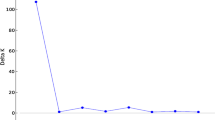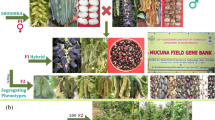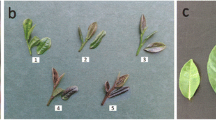Abstract
Tea is an important health drink which contributes significantly to the economy of Asian and African countries. India contributes about 29 % of the world’s total tea production where majority of the tea cultivated is Assam type (native to Assam, India). Apart from India, Assam type contributes to the majority of tea grown in tropical regions of Sri Lanka and Kenya as well. We have developed the first genetic linkage map in Indian beveragial tea using 234 DNA markers (AFLP and RAPD). The plausibility of the linkage group formation was compared using two-way pseudo-testcross approach (using maximum likelihood algorithm) and integrated approaches (using regression algorithm). Both the approaches generated linkage maps containing 18 linkage groups. The composition and order of markers in the corresponding linkage groups in both the maps showed significant congruence. Maximum likelihood algorithm could map 78.6 % of the markers with total map length of 8527.5 and 45.3 cM average distance between each marker. Regression algorithm could map 73.5 % of the total markers with total map length of 2051.7 and 14.96 cM average distance between each marker. Drought is the major abiotic stress responsible for heavy yield losses in cultivated tea all over the world. The present map was used to map the locus, AFLP_CS_87 that segregates with drought tolerance phenotype in both the maps.










Similar content being viewed by others
References
Banerjee B (1992) Selection and breeding of tea. In: Wilson KC, Clifford MN (eds) Tea cultivation to consumption. Chapman and Hall, London, pp 53–81
Banerjee GD, Banerji S (2008) Global tea trade. In: Tea industry: a road map ahead. Abhijeet Publications, Delhi
Barrett BA, Kidwell K (1998) AFLP-based genetic diversity assessment among wheat cultivars from the Pacific North-west. Crop Sci 38:261–1271
Basu M, Bera AB, Rajan A (2010) Tea statistics: global scenario. Inc J Tea Sci 8:121–124
Behrend A, Borchert T, Spiller M, Hohe A (2013) AFLP-based genetic mapping of the “bud-flowering” trait in heather (Calluna vulgaris). BMC Genet 14:64
Bhagat RM, Baruah RD, Safique S (2010) Climate and tea [Camellia sinensis (L.) O. Kuntze] Production with special reference to North Eastern India: a review. J Environ Res Dev 4(4):1017–1028
Bradshaw JHD, Villar M, Watson BD, Otto KG, Stewart S, Stettler RF (1994) Molecular genetics of growth and development in Populus. III. A genetic linkage map of a hybrid poplar composed of RFLP, STS, and RAPD markers. Theor Appl Genet 89(2–3):167–178
Burgess PJ, Carr MKV (1996) Responses of young tea (Camellia sinensis) clones to drought and temperature. II. Dry matter production and partitioning. Exp Agric 32(04):377–394
Carlier JD, Sousa NH, Santo TE, d’Eeckenbrugge GC, Leitao JM (2012) A genetic map of pineapple (Ananas comosus (L.) Merr.) including SCAR, CAPS, SSR and EST-SSR markers. Mol Breed 29(1):245–260
Cartwright DA, Troggio M, Velasco R, Gutin A (2007) Genetic mapping in the presence of genotyping errors. Genetics 176(4):2521–2527
Cervera MT, Storme V, Ivens B, Gusmao J, Liu BH, Hostyn V, Slycken JV, Montagu MV, Boerjan W (2001) Dense genetic linkage maps of three Populus species (Populus deltoides, P. nigra and P. trichocarpa) based on AFLP and microsatellite markers. Genetics 158(2):787–809
Chalmers KJ, Campbell AW, Kretschmer J, Karakousis A, Henschke PH, Pierens S, Harker N, Pallotta M, Cornish GB, Shariflou MR, Rampling LR, McLauchlan A, Daggard G, Sharp PJ, Holton TA, Sutherland MW, Appels R, Langridge P (2001) Construction of three linkage maps in bread wheat, Triticum aestivum. Crop Pasture Sci 52(12):1089–1119
Chen X, Hao S, Wang L, Fang W, Wang Y, Li X (2012) Late-acting self-incompatibility in tea plant (Camellia sinensis). Biologia 67(2):347–351
Collard BCY, Mackill D (2008) Marker-assisted selection: an approach for precision plant breeding in the twenty-first century. Philos Trans R Soc Biol Sci 363(1491):557–572
Demeke TSB, Hucl P, Chibbar RN (1997) Random amplified polymorphic DNA (RAPD) in cereal improvement. Maydica 42:133–142
Dettori MT, Quarta R, Verde I (2001) A peach linkage map integrating RFLPs, SSRs, RAPDs, an morphological markers. Genome 44(5):783–790
Doucleff M, Jin Y, Gao F, Riaz S, Krivanek AF, Walker MA (2004) A genetic linkage map of grape, utilizing Vitis rupestris and Vitis arizonica. Theor Appl Genet 109(6):1178–1187
Dudley JW (1993) Molecular markers in plant improvement: manipulation of genes affecting quantitative traits. Crop Sci 33(4):660–668
Foisset N, Delourme R (1996) Segregation distortion in androgenic plants. In: Jain SM, Sopory SK,Veilleux RE (eds) In vitro haploid production in higher plants. Springer, Dordrecht, pp 189–201
Garcia AAF, Kido EA, Meza AN, Souza HMB, Pinto LR, Pastina MM, Leite CS, da Silva JAG, Ulian EC, Figueira A, Souza AP (2006) Development of an integrated genetic map of a sugarcane (Saccharum spp.) commercial cross, based on a maximum-likelihood approach for estimation of linkage and linkage phases. Theor Appl Genet 112(2):298–314
Grattapaglia D, Sederoff R (1994) Genetic linkage maps of Eucalyptus grandis and Eucalyptus urophylla using a pseudo-testcross: mapping strategy and RAPD markers. Genetics 137(4):1121–1137
Gupta S, Bharalee R, Bhorali P, Bandyopadhyay T, Gohain B, Agarwal N, Ahmed P, Saikia H, Borchetia S, Kalita MC, Handique AK, Das S (2012) Identification of drought tolerant progenies in tea by gene expression analysis. Funct Integr Genomics 12(3):543–563
Hackett CA, Broadfoot LB (2003) Effects of genotyping errors, missing values and segregation distortion in molecular marker data on the construction of linkage maps. Heredity 90(1):33–38
Hackett CA, Wachira FN, Paul S, Powell W, Waugh R (2000) Construction of a genetic linkage map for Camellia sinensis (tea). Heredity 85(4):346–355
Haldane JBS (1919) The combination of linkage values and the calculation of distances between the loci of linked factors. J Genet 8(29):299–309
He Dan Y, Liu MCai, Pan H, Zhang Q (2014) The first genetic linkage map of Crape myrtle (Lagerstroemia) based on amplification fragment length polymorphisms and simple sequence repeats markers. Plant Breed 133(1):138–144
Hu CY, Lee TC, Tsai HT, Tsai YZ, Lin SF (2013) Construction of an integrated genetic map based on maternal and paternal lineages of tea (Camellia sinensis). Euphytica 191(1):141–152
Huang X, Zeller FJ, Hsam SLK, Wenze G, Mohler V (2000) Chromosomal location of AFLP markers in common wheat utilizing nulli-tetrasomic stocks. Genome 43:298–305
Jain NK (1999) Global advances in tea science. Aravali Books International, New Delhi, p 882
Jansen J (2001) Constructing dense genetic linkage maps. Theor Appl Genet 102:1113–1122
Joobeur T, Periam N, de Vicente MC, King GJ, Arusn P (2000) Development of a second generation linkage map for almond using RAPD and SSR markers. Genome 43(4):649–655
Julier B, Flajoulot S, Barre P, Cardinet G, Santoni S, Huguet T, Huyghe C (2003) Construction of two genetic linkage maps in cultivated tetraploid alfalfa (Medicago sativa) using microsatellite and AFLP markers. BMC Plant Biol 3(1):9
Kamunya SM, Wachira FN, Pathak RS, Korir R, Sharma V, Kumar R, Bhardwaj P, Chalo R, Ahuja PS, Sharma RK (2010) Genomic mapping and testing for quantitative trait loci in tea (Camellia sinensis (L.) O. Kuntze). Tree Genet Genomes 6(6):915–929
Keyser DE, Shu Q, Bockstaele EV, De Riek J (2010) Multipoint-likelihood maximization mapping on 4 segregating populations to achieve an integrated framework map for QTL analysis in pot azalea (Rhododendron simsii hybrids). BMC Mol Biol 11(1):1
Kigalu JM (2007) Effects of planting density and drought on the productivity of tea clones (Camellia sinensis L.): yield responses. Phys Chem Earth Parts A/B/C 32(15):1098–1106
Knox MR, Ellis TNH (2002) Excess heterozygosity contributes to genetic map expansion in pea recombinant inbred populations. Genetics 162(2):861–873
Kosambi DD (1943) The estimation of map distances from recombination values. Ann Eugen 12(1):172–175
Ky CL, Barre P, Lorieux M, Trouslot P, Akaffou S, Louarn J, Charrier A, Hamon S, Noirot M (2000) Interspecific genetic linkage map, segregation distortion and genetic conversion in coffee (Coffea sp.). Theor Appl Genet 101(4):669–676
Maliepaard C, Jansen J, Van Ooijen JW (1997) Linkage analysis in a full-sib family of an outbreeding plant species: overview and consequences for applications. Genet Res 70(03):237–250
Menz MA, Klein RR, Unruh NC, Rooney WL, Klein PE, Mullet JE (2004) Genetic diversity of public inbreds of sorghum determined by mapped AFLP and SSR markers. Crop Sci 44(4):1236–1244
Moreira FM, Madini A, Marino R, Zulini L, Stefanini M, Velasco R, Kozma P, Grando MS (2011) Genetic linkage maps of two interspecific grape crosses (Vitis sp.) used to localize quantitative trait loci for downy mildew resistance. Tree Genet Genomes 7(1):153–167
Mueller UG, Wolfenbarger LL (1999) AFLP genotyping and fingerprinting. Trends Ecol Evol 14(10):389–394
Muoki RC, Wachira FN, Pathak R, Kamunya SM (2007) Potential male gametophyte competition among Camellia sinensis genotypes in isolated biclonal seed orchards. Afr Crop Sci 15(2):59–66
Oliveira EJ, Vieira MLC, Garcia AAF, Munhoz CF, Margarido GRA, Consoli L, Matta FP, Moraes MC, Zucchi MI, Fungaro MHP (2008) An integrated molecular map of yellow passion fruit based on simultaneous maximum-likelihood estimation of linkage and linkage phases. J Am Soc Hortic Sci 133(1):35–41
Park YH, Sensoy S, Wye C, Antonise R, Pelema J, Havey MJ (2000) A genetic map of cucumber composed of RAPDs, RFLPs, AFLPs, and loci conditioning resistance to papaya ringspot and zucchini yellow mosaic viruses. Genome 43(6):1003–1010
Parker GD, Chalmers KJ, Rathjen AJ, Langridge P (1998) Mapping loci associated with flour colour in wheat (Triticum aestivum L.). Theor Appl Genet 96:238–245
Paterson AH (1996) Making genetic maps. In: Paterson AH (ed) Genome mapping in plants. Academic Press, San Diego, pp 23–39
Porebski SL, Bailey G, Baum BR (1997) Modification of a CTAB DNA extraction protocol for plants containing high polysaccharide and polyphenol components. Plant Mol Biol Rep 15(1):8–15
Reinisch AJ, Dong J, Brubaker CL, Stelly DM, Wendel JF, Paterson AH (1994) A detailed RFLP map of cotton, Gossypium hirsutum × Gossypium barbadense: chromosome organization and evolution in a disomic polyploid genome. Genetics 138(3):829–847
Ruiz R, Dendauw IJ, Bockstaele EV, Depicker A, Loose MD (2000) AFLP markers reveal high polymorphic rates in ryegrasses (Lolium spp.). Mol Breed 6(2):125–134
Schwarz G, Herz M, Huang XQ, Michalek W, Jahoor J, Wenzel G, Mohler V (2000) Application of fluorescent-based semi-automated AFLP analysis in barley and wheat. Theor Appl Genet 100:545–551
Semagn K, Bjornstad A, Skinnes H, Maroy AG, Tarkegne Y, William M (2006) Distribution of DArT, AFLP, and SSR markers in a genetic linkage map of a doubled-haploid hexaploid wheat population. Genome 49(5):545–555
Shirasawa K, Asamizu E, Fukuoka H, Ohyama A, Sato S, Nakamura Y, Tabata S et al (2010) An interspecific linkage map of SSR and intronic polymorphism markers in tomato. Theor Appl Genet 121(4):731–739
Stam P (1993) Construction of integrated genetic linkage maps by means of a new computer package: Join Map. The Plant J 3(5):739–744
Takeda Y (1990) Cross compatibility of tea (Camellia sinensis) and its allied species in the genus Camellia. Jpn Agric Res Q 24(14):111–116
Tan LQ, Wang LY, Wei K, Zhang CC, Wu LY, Qi GN, Cheng H, Zhang Q, Cui QM, Liang JB (2013) Floral transcriptome sequencing for SSR marker development and linkage map construction in the tea plant (Camellia sinensis). PLoS One 8(11):e81611
Taniguchi F, Furukawa K, Metoku SO, Yamaguchi N, Ujihara T, Kono I, Fukuoka H, Tanaka J (2012) Construction of a high-density reference linkage map of tea (Camellia sinensis). Breed Sci 62(3):263
Tanksley SD, Ganal MW, Prince JP, De Vicente MC, Bonierbale MW, Broun P, Fulton TM, Giovannoni JJ, Grandillo S, Martin GB (1992) High density molecular linkage maps of the tomato and potato genomes. Genetics 132(4):1141–1160
Thakur D, Das SC, Sabhapondit S, Tamuly P, Deka DK (2011) Antimicrob activities of Tocklai vegetative tea clones. Indian J Microbiol 51(4):450–455
Tomo N, Fuchinoue Y, Fuchinoue H (1956) Studies on self-fertilization of the tea plant. Tea Res 7:14–20
Ubi BE, Fujimori M, Mano Y, Komatsu T (2004) A genetic linkage map of Rhodes grass based on an F1 pseudo-testcross population. Plant Breed 123(3):247–253
Upadhyaya H, Panda SK, Dutta BK (2011) CaCl2 improves post-drought recovery potential in Camellia sinensis (L.) O. Kuntze. Plant Cell Rep 30(4):495–503
Van Ooijen JW (2006) JoinMap 4.0, software for the calculation of genetic linkage maps. Wageningen, Kyazama BV
Vorrips RE (2002) MapChart: software for the graphical presentation of linkage maps and QTLs. J Hered 93(1):77–78
Wang D, Li Y, Li L, Wei Y, Li Z (2014) The first genetic linkage map of Eucommia ulmoides. J Genet 93(1):13
Wood DJ, Barua DN (1958) Species hybrids of tea. Nature 181:1674–1675
Woolbright SA, DiFazio SP, Yin T, Martinsen GD, Zhang X, Allan GJ, Whitham TG, Keim P (2008) A dense linkage map of hybrid cottonwood (Populus fremontii × P. angustifolia) contributes to long-term ecological research and comparison mapping in a model forest tree. Heredity 100(1):59–70
Wu SB, Collins G, Sedgley M (2004) A molecular linkage map of olive (Olea europaea L.) based on RAPD, microsatellite, and SCAR markers. Genome 47(1):26–35
Xie W, Zhang X, Cai H, Huang L, Peng Y, Ma X (2010) Genetic maps of SSR and SRAP markers in diploid orchard grass (Dactylis glomerata L.) using the pseudo-testcross strategy. Genome 54(3):212–221
Yamagishi M, Takeuchi Y, Tanaka I, Kono I, Murai K, Yano M (2010) Segregation distortion in F2 and doubled haploid populations of temperate japonica rice. J Genet 89(2):237
Yang WA, Goodwin I, Schertz K, Bennetzen JL (1996) Comparison of DNA marker technologies in characterizing plant genome diversity: variability in Chinese sorghums. Crop Sci 36:1669–1676
Yin TM, DiFazio SP, Gunter LE, Riemenschneider D, Tuskan GA (2004) Large-scale heterospecific segregation distortion in Populus revealed by a dense genetic map. Theor Appl Genet 109:451–463
Acknowledgments
Authors would like to thank Department of Biotechnology, India for financial aid to carry out the research work and University of Delhi for the infrastructural support.
Author information
Authors and Affiliations
Corresponding author
Electronic supplementary material
Below is the link to the electronic supplementary material.
Rights and permissions
About this article
Cite this article
Bali, S., Mamgain, A., Raina, S.N. et al. Construction of a genetic linkage map and mapping of drought tolerance trait in Indian beveragial tea. Mol Breeding 35, 112 (2015). https://doi.org/10.1007/s11032-015-0306-5
Received:
Accepted:
Published:
DOI: https://doi.org/10.1007/s11032-015-0306-5




